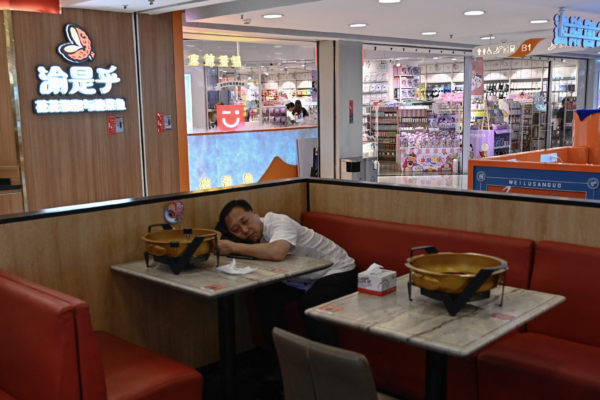The latest data shows that in July, China’s narrow money supply (M1) decreased by 6.6% annually, while the cumulative increment of social financing reached 18.87 trillion yuan, showing a year-on-year decrease of 3.22 trillion yuan. Experts point out that the decline in M1, which represents the current economic expansion vitality, and the reduced flow of funds into the real economy imply that businesses are in a state of stagnation. They believe that since 2018, the real engine driving China’s economy has not been investment and consumption as commonly thought, but rather solely export, which the Chinese Communist Party has consistently misjudged as the growth engine.
The People’s Bank of China recently released the “July 2024 Financial Statistics Report”, indicating that as of the end of July, the broad money supply (M2) balance was 303.31 trillion yuan, up by 6.3% year-on-year. The narrow money supply (M1) balance was 63.23 trillion yuan, marking a 6.6% decrease annually. The currency in circulation (M0) balance was 11.88 trillion yuan, showing a 12% increase year-on-year. Cash injection in the first seven months hit a record low of 539.6 billion yuan.
Narrow money supply (M1) includes currency in circulation (M0) and demand deposits of enterprises. David Wong, an economist based in the United States, told Epoch Times that the deceleration of M1 indicates an overall reduction in private economic activities and reserves, signifying an enduring economic downturn that has already affected the savings of businesses or potential future investments. The slowing down of M1 signifies that businesses have currently stagnated.
Wong explains that although the growth rate of M2 indicates a continuous increase in the issuance of the renminbi, it has not affected the speed of M1, indicating that the injected renminbi has not flowed into businesses that impact economic development, thereby showing no positive economic effects. It also implies that the monetary tools of the People’s Bank of China have become ineffective.
The data released by the People’s Bank of China confirms that the slowdown in M1 is due to the lack of willingness among businesses to expand economic activities. The data shows that in the first seven months, the cumulative increment of social financing reached 18.87 trillion yuan, a decrease of 3.22 trillion yuan compared to the same period last year.
Social financing scale refers to the total amount of funds that the real economy obtains from the financial system, which includes financing and lending activities of enterprises or individuals and reflects the willingness of borrowing in social economic activities.
Looking at different sectors, both the corporate and residential sectors showed relatively weak performance, with an increase in the proportion of bill financing. Specifically, loans to enterprises increased by 130 billion yuan, including a decrease of 550 billion yuan in short-term loans, an increase of 130 billion yuan in medium and long-term loans, and an increase of 558.6 billion yuan in bill financing. Loans from non-banking financial institutions increased by 205.7 billion yuan, while residential loans decreased by 210 billion yuan in July, including a 215.6 billion yuan drop in short-term loans and a 10 billion yuan increase in medium and long-term loans.
Typically, a decrease in short-term corporate loans indicates the current production intentions of businesses, and the 550 billion yuan reduction in short-term loans suggests that businesses have stopped borrowing or potentially even repaying loans. On the other hand, residential loans are usually used for purchasing homes, cars, etc., and the 210 billion yuan decrease in loans in July confirms a low willingness among residents to buy houses, reflecting a lack of demand in the real estate market.
David Wong notes that the sharp decline in borrowing intentions among residents and businesses has led to a significant amount of money being idle within the financial system, not being channeled into the real economy, mainly due to the weak borrowing willingness.
China’s stock market, which serves as a barometer of economic dynamics, has recently been in a slump. From August 12th to 14th, the total turnover in the Shanghai, Shenzhen, and Beijing markets were 498.657 billion yuan, 479.877 billion yuan, and 480.186 billion yuan, respectively, marking three consecutive trading days where the turnover fell below the 500 billion yuan mark, hitting a new low in nearly five years.
On August 14th, the three major stock indexes in A-shares fluctuated throughout the day, with the Shanghai Composite Index falling by 0.6% to 2,850.65 points, once again dropping below the 2,900-point mark. In addition, the Shenzhen Component Index fell by 1.17%, while the Growth Enterprise Market Index dropped by 1.42%.
Regarding the stock market decline, Shao Yu, a senior researcher at the National Finance and Development Laboratory of the Chinese government, joked during the “2024 Boao Real Estate Forum” held in Hainan from August 13th to 16th, saying, “When I entered the industry, A-shares were defending 3,000 points, and now, as I’m nearing retirement, we’re defending 2,900 points. It feels like my entire career has been a ‘defense battle’.”
Various experts offer different perspectives on the issues within the Chinese economy. David Wong explains, “It is generally believed that the ‘three engines’ driving the Chinese economy are investment, consumption, and exports. However, since 2018, it should be clear that the growth seen in China’s economy over the past 40 years of reform and opening up has not been mainly driven by investment and consumption but solely by exports.”
He adds, “The Chinese Communist Party has consistently misjudged the growth engine of the economy, mistakenly believing it to be investment and the real estate sector, while in reality, they simply serve the export sector.”
Currently, exports remain the only engine in the Chinese economy that hasn’t completely stalled. Yet, with the comprehensive ideological and geopolitical confrontation between the Chinese Communist Party and Europe and America, as well as the harsh environment with China’s “delinking” and the imposition of tariffs on new Chinese goods by Europe and America, the sustainability of China’s exports attracts considerable attention.

